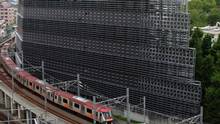Japan Stokes Renewable Energy Plan.
 First it was Europe and then it was China, but as the world absorbs the impact of Tokyo’s decision to phase out nuclear power over the next three decades, some are starting to ask whether the next big centre of renewable energy growth will be Japan.
First it was Europe and then it was China, but as the world absorbs the impact of Tokyo’s decision to phase out nuclear power over the next three decades, some are starting to ask whether the next big centre of renewable energy growth will be Japan.“It is absolutely possible,” says Jim Long of Greentech Capital Advisors, a global adviser on renewable energy, headquartered in New York.
“This could provide a significant stimulus for the development of a major renewable energy market in Japan, and underpin the global ambitions of a number of large Japanese industrial companies in the clean energy sector.”
Japan certainly does not lack green energy ambition.
In line with last month’s decision, the country has plans that envisage the investment of ¥38-trillion ($483-billion U.S.) in non-hydroelectric renewable energy, such as solar and wind power, over the next two decades, plus an extra ¥84-trillion in energy-efficient technology.
This will come on top of the introduction in July of some of the world’s most generous low-carbon energy subsidies, which have already spurred an estimated $2-billion of investment.
Some unlikely companies are already entering the renewables field, including mobile phone group SoftBank, which is planning to build several solar parks and a wind farm.
Still, turning into a clean power giant would be a big shift for a country that generated 30 per cent of its electricity from nuclear power before last year’s meltdown at the Fukushima nuclear power plant, and less than 1 per cent from wind and solar power.
Japan has several substantial wind turbine makers, such as Mitsubishi Heavy Industries Ltd., Japan Steel Works Ltd. and Fuji Heavy Industries Ltd., but none of them were among the 10 biggest wind companies by market share last year.
Among its solar cell makers, only two – Sharp Corp. and Kyocera Corp. – were on a list of the world’s 20 biggest by production in 2011, according to a report last month by the Joint Research Centre of the European Commission.
Both companies are solar pioneers (Sharp started commercial solar production in 1963) but today’s undisputed solar power giant is China, where newcomers such as Suntech Power Holdings Co. Ltd., Yingli Green Energy Holding Co. Ltd., and Trina Solar dominate the top 20 global players.
China’s entry into the wind turbine market has been equally remarkable. Six years ago, not a single Chinese turbine maker was among the top 10 manufacturers. Last year there were four: Goldwind Science and Technology Co. Ltd., Sinovel Wind Group Co., United Power Technology Co. and Ming Yang Wind Power Group Ltd. – according to Bloomberg New Energy Finance.
But it is unclear how much benefit companies outside Japan will see from any green Japanese boom.
Even if China and Japan were not embroiled in a noisy row over a group of contested islands in the East China Sea, recent history suggests Chinese companies may struggle to penetrate a bigger Japanese renewables market.
Chinese wind companies have been expanding rapidly around the world, but have yet to make a single sale in Japan.
And Japan accounts for a very small proportion of Chinese solar companies’ global sales, although companies such as Yingli, which opened regional headquarters in Tokyo in May are trying to change that.
The entry hurdles are high for non-Japanese companies, says Aris Karcanias of Navigant’s BTM wind industry consultancy.
“They know they would have to compete with Japanese suppliers who are very much in favour of their local and established supply chain,” he says. “It isn’t about putting up economic barriers. It’s about comfort and it’s about relationships.”
Still, Japan is unlikely to attract heavy investment from foreign companies until its wind market has annual installation rates of around 1 to 1.5 gigawatts, he says. (Japan’s entire accumulated wind power capacity was only 2.5GW at the end of 2011).
One European company that thinks it could eventually benefit from Japan’s clean energy push is Siemens AG, the German industrial giant whose wind turbine division was the world’s fifth biggest last year in terms of market share.
Japan is not the most promising candidate for wind power. Being a smallish archipelago, it does not have much room for turbines onshore and because its coastal waters are so deep, it is hard to install them offshore.
Siemens, however, has developed a floating wind turbine, which could be used in such deep waters.
“It is very suitable for Japan because you have limited areas where you can reach the sea bottom, unlike the U.K. and elsewhere,” says Mike Hannibal, head of offshore wind in Europe, the Middle East and Africa at Siemens Wind Power.
Floating turbines are 10 years away from mass deployment, many analysts believe, and in the meantime, there is Denmark’s Vestas Wind Systems. The world’s biggest wind turbine maker has already made big strides into Japan, where it has installed more than 400 turbines.
But after a bout of financial woes, it confirmed in August it was in talks with Japan’s Mitsubishi Heavy Industries about “a potential strategic co-operation.”
If the two end up combining, it could create a formidable low-carbon player in Japan and beyond. This is still far from being a certainty, but other wind turbine manufacturers hoping to exploit a growing green market in Japan will be hoping it never happens.
You can return to the main Market News page, or press the Back button on your browser.

